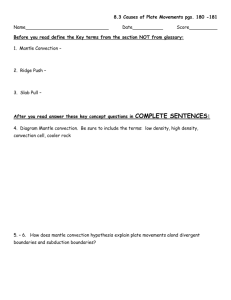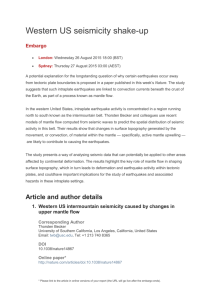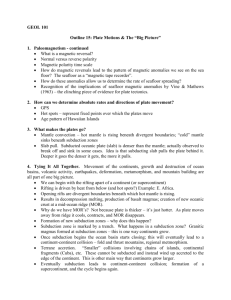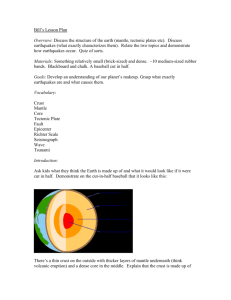Subduction zones Lecture by Rob van der Hilst
advertisement
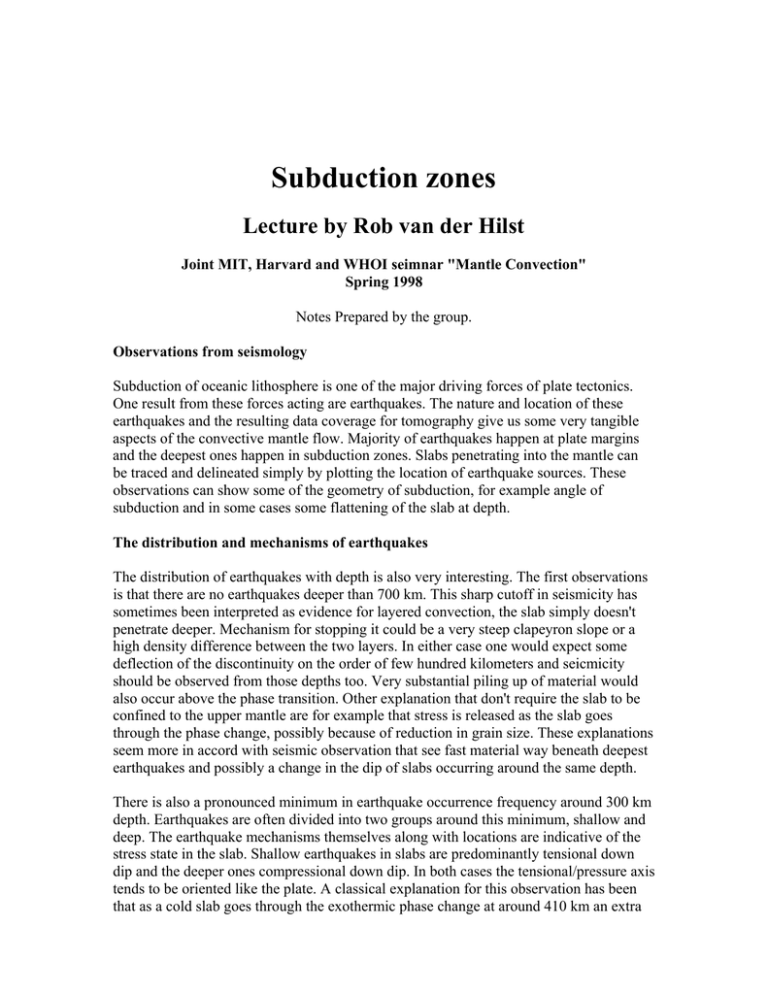
Subduction zones Lecture by Rob van der Hilst Joint MIT, Harvard and WHOI seimnar "Mantle Convection" Spring 1998 Notes Prepared by the group. Observations from seismology Subduction of oceanic lithosphere is one of the major driving forces of plate tectonics. One result from these forces acting are earthquakes. The nature and location of these earthquakes and the resulting data coverage for tomography give us some very tangible aspects of the convective mantle flow. Majority of earthquakes happen at plate margins and the deepest ones happen in subduction zones. Slabs penetrating into the mantle can be traced and delineated simply by plotting the location of earthquake sources. These observations can show some of the geometry of subduction, for example angle of subduction and in some cases some flattening of the slab at depth. The distribution and mechanisms of earthquakes The distribution of earthquakes with depth is also very interesting. The first observations is that there are no earthquakes deeper than 700 km. This sharp cutoff in seismicity has sometimes been interpreted as evidence for layered convection, the slab simply doesn't penetrate deeper. Mechanism for stopping it could be a very steep clapeyron slope or a high density difference between the two layers. In either case one would expect some deflection of the discontinuity on the order of few hundred kilometers and seicmicity should be observed from those depths too. Very substantial piling up of material would also occur above the phase transition. Other explanation that don't require the slab to be confined to the upper mantle are for example that stress is released as the slab goes through the phase change, possibly because of reduction in grain size. These explanations seem more in accord with seismic observation that see fast material way beneath deepest earthquakes and possibly a change in the dip of slabs occurring around the same depth. There is also a pronounced minimum in earthquake occurrence frequency around 300 km depth. Earthquakes are often divided into two groups around this minimum, shallow and deep. The earthquake mechanisms themselves along with locations are indicative of the stress state in the slab. Shallow earthquakes in slabs are predominantly tensional down dip and the deeper ones compressional down dip. In both cases the tensional/pressure axis tends to be oriented like the plate. A classical explanation for this observation has been that as a cold slab goes through the exothermic phase change at around 410 km an extra load is created, pulling the plate down. The opposite happens at the endothermic 660 km discontinuity and the slab is retarded. Even though the slab is still sinking under its own weight at 660, it sinks slower than at 410, creating compression in the middle. The focal mechanisms that seem to best fit those data is double coupling for earthquakes at all depths. For shallow earthquakes this can simply be explained with brittle failure. At depth, temperatures and pressures are to high for brittle failure. The mechanics of deep earthquakes remain enigmatic but one explanation for the existence of fault planes at this depth is large surfaces of metastable olivine collapsing to stable spinel. The subducted plate goes too fast through the 410 km discontinuity to let the olivine spinel transition take place in equilibrium. The latent heat released by the first olivine to go through the transition can even decrease the viscosity and increase the rate of subduction. The interior of the slab is colder than the surface and a metastable olivine wedge is created within it. It is buoyant creating compressional forces. Since the olivine can be way beyond its stability field at depth, the transformation to spinel can be very abrupt and sudden over large volume. Furthermore, volume decreases with the transformation and a surface can be created with little mechanical coupling between the two sides giving rise to an earthquake, often with high stress drops. The frictional heat resulting from the movement along the plane probably melts the surroundings, giving further lubrication. The fault plane area of deep earthquakes is often huge, sometimes larger than can be explained with wedges inside a slab with thickness similar to a oceanic plates. This argument can be circumvent with thickening of the slab above the 660, like mentioned before. Layered vs. whole mantle convection The discontinuity at approximately 660 km is caused by the transformation of spinel to perovskite and magnesiowustite. It has often been postulated that this barrier of increased density and viscosity splits the mantle up in two convection cells, upper and lower mantle, with very little or no material flux across the boundary. The main arguments for this have been some geochemical observations and the cutoff in seismicity around 700 km depth. Images from seismic tomography have on the other hand suggested that there is a lot of exchange of material between the upper and lower mantle. Some of them show a continuos, faster than average, structures stretching from known areas of subduction at the surface and down to the core mantle boundary. Faster materials are generally considered to be colder than the surroundings. This is attributed to the change in elastic constants, the resulting change in density goes in the other direction. It is difficult to explain these images with thermal coupling between the two layers, since it is a relatively slow process. Continuous flow across the boundary is a lot simpler explanation and correlation with subduction history is often very good. This has been interpreted as evidence for whole mantle convection scheme, with no significant contributions from the discontinuities in the overall picture. When looked upon closer the style of mantle convection doesn't follow one of the end member models completely. In the simplest cases with stationary trenches and well defined geometries the slabs seem to go straight into the lower mantle. There may however be a slight hesitation and some thickening of the slab before it gains enough weight to cross the boundary. In more complex situations there are other factors that determine some aspects of the flow. A plate that is overridden by a fast migrating trench is more likely to be flattened out and laid down along the 660 discontinuity. The exact position of the flattening seems to vary, above, along or beneath the discontinuity. In the end it looks like the pull of gravity overcomes the viscosity difference and the slabs penetrate into the lower mantle. This control of lateral displacements on the surface has been confirmed with both numerical and analog experiments. In this way the transition zone, coupled with rapid motions and various geometries on the surface, distort the flow and makes it transient in nature. This complex feedback system with lot of short lived features can make it hard to determine a general style of subduction. The material flux between the upper and the lower mantle can be very uneven and change a lot in a relatively short time. Mantle convection is very complicated and with many controlling factors. The two end member models are not adequate in explaining all the observations. Some kind of a compromise between them seems to be the best working model.
